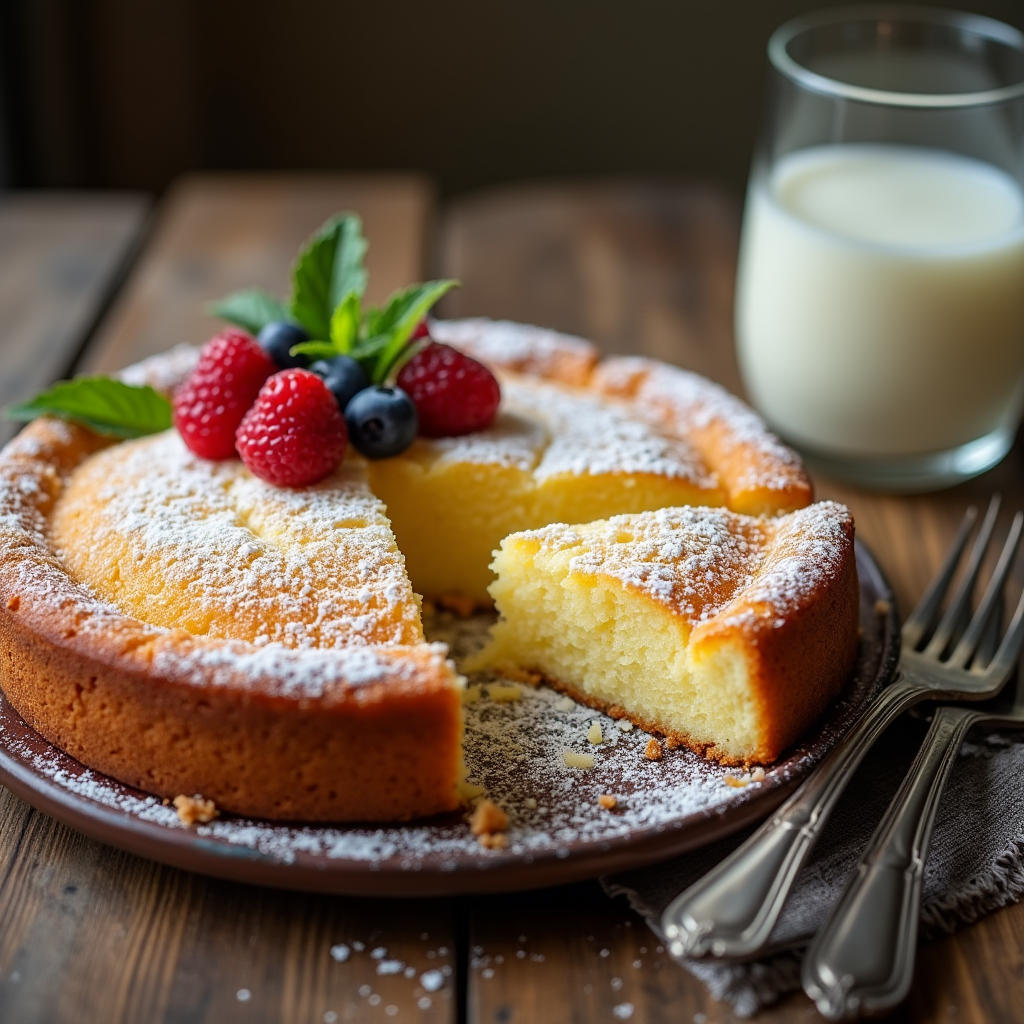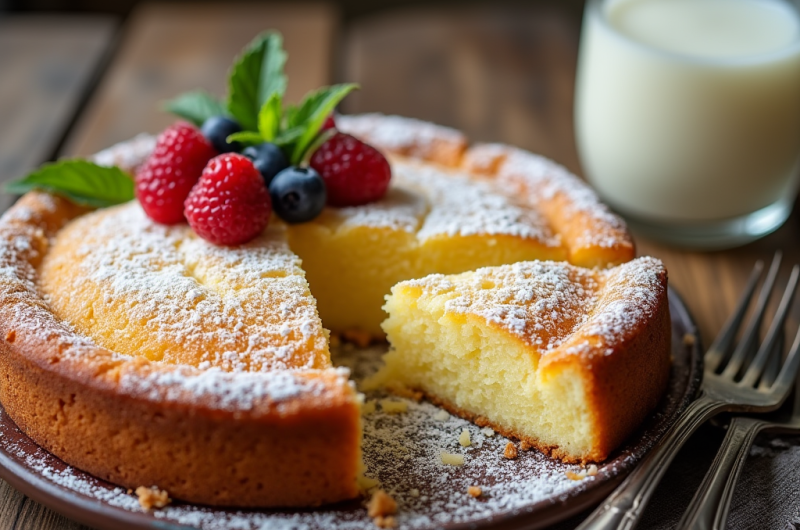Kefir Sheet Cake
Picture this: a moist, tender sheet cake with a subtle tangy sweetness, made effortlessly with probiotic-rich Kefir—a fermented dairy superstar that adds both flavor and gut-friendly benefits.
Whether you’re baking for a birthday potluck or just craving a simple dessert, this kefir sheet cake recipe is your new go-to. Not only does Kefir guarantee a light, airy crumb, but it also replaces buttermilk or yogurt for a uniquely balanced taste.
And the best part? We’ve included a free printable recipe card (with step-by-step tips!) to streamline your baking process. Save time, reduce kitchen chaos, and impress your guests with a dessert that’s as wholesome as it is delicious. Let’s dive into why this recipe deserves a permanent spot in your dessert rotation!
1: Why Kefir Sheet Cakes Are a Must-Try
1: The Magic of Kefir in Baking
Kefir isn’t just a trendy probiotic drink—it’s a secret weapon for bakers! Here’s why it transforms this sheet cake into a standout dessert:
- Tangy Flavor Boost: Kefir’s natural fermentation gives the cake a subtle, refreshing tang that balances sweetness, similar to buttermilk or yogurt, but with a lighter profile.
- Moisture Magnet: The lactic acid in Kefir tenderizes gluten, ensuring a soft, moist crumb that stays fresh for days. Unlike oil-heavy cakes, Kefir adds moisture without greasiness.
- Probiotic Power: While most baked goods lose probiotics during baking, Kefir’s enzymes still contribute to gut-friendly benefits. For a stronger probiotic punch, pair the cake with a kefir-based frosting or fresh fruit topping.
- Flexible Substitutes: No kefir? No problem! Swap it 1:1 with buttermilk (for a similar tang), plain yogurt (thicker texture), or even soured milk (1 cup milk + 1 tbsp lemon juice). For vegan bakers, coconut kefir or almond milk kefir works beautifully.
Pro Tip: “For extra lift, mix kefir with baking soda—the acid-base reaction creates bubbles that make the cake airy!”
2: Sheet Cakes vs. Layer Cakes: Why Simplicity Wins
Sheet cakes are the unsung heroes of dessert tables, and here’s why they outshine layer cakes for stress-free baking:
- Faster Baking Time: A thin, even layer in a sheet pan bakes in 25-30 minutes (vs. 40+ minutes for layered cakes), reducing oven time and energy use.
- Feeds a Crowd: A standard 9×13-inch sheet cake serves 12-15 people—ideal for birthdays, potlucks, or office parties. No slicing tiny slivers!
- No Fancy Skills Required: Skip the crumb-coating, stacking, or delicate frosting. Sheet cakes are forgiving: bake, cool, and top with a simple glaze, whipped cream, or sprinkles.
- Portability: Lightweight and easy to transport, sheet cakes won’t slide or collapse in transit. Perfect for outdoor picnics or school events.
When to Choose Sheet Cakes:
- Last-minute gatherings
- Beginner-friendly baking
- Summer parties (pair with fresh berries!)
Bonus: “Sheet cakes freeze better than layered ones—wrap slices in parchment paper for grab-and-go treats!”
3: What Makes This Recipe Special
This isn’t just another cake recipe—it’s designed for real-life success, whether you’re a novice or a seasoned baker:
- Foolproof Steps: The recipe uses a straightforward “dump-and-mix” method. No creaming butter or folding egg whites—whisk dry and wet ingredients, then combine!
- Minimal Tools: All you need is a sheet pan, mixing bowls, and a whisk (no stand mixer required). Even the baking time is flexible—use a toothpick test to avoid overbaking.
- Printable Recipe Card: Forget scribbling notes! Our free downloadable card includes:
- Precise measurements (metric + imperial)
- Visual doneness cues (e.g., “edges pulling from the pan”)
- Storage tips and customization ideas (e.g., lemon zest or chocolate chips)
- Dietary Flexibility: The base recipe is easy to adapt—use gluten-free flour, coconut sugar, or flax eggs for nutritional needs.
Why Bakers Love It:
- “I made this for my kid’s bake sale—it was ready in under an hour, and everyone asked for the recipe!”
- “The printable card is a lifesaver—I laminated mine and keep it in my recipe binder!”
2: Ingredients & Tools You’ll Need
1: Essential Ingredients for a Moist Kefir Cake
This recipe balances simplicity with flexibility. Here’s what you’ll need (and why each ingredient matters):
Core Ingredients:
- Kefir (1 cup / 240ml): The star ingredient! Use plain, unsweetened Kefir for tang and moisture. Dairy-free? Substitute with coconut milk kefir or almond milk kefir.
- All-Purpose Flour (2 cups / 250g): Provides structure. For gluten-free, swap 1:1 with a GF blend (add ½ tsp xanthan gum if needed).
- Granulated Sugar (1 cup / 200g): Balances kefir’s tang. For a less refined option, try coconut sugar (note: darker color).
- Eggs (2 large): Bind the batter. Vegan? Use flax eggs (2 tbsp ground flaxseed + 5 tbsp water, rested for 5 minutes).
- Baking Powder (2 tsp): Ensures a light, airy rise.
- Vanilla Extract (1 tsp): Enhances flavor. Substitute with almond extract or citrus zest for a twist.
- Neutral Oil (½ cup / 120ml): Use avocado oil, sunflower oil, or melted coconut oil for moisture without overpowering flavor.
- Salt (½ tsp): Balances sweetness and enhances depth.
Pro Tips:
- “Room-temperature ingredients mix better! Take eggs and kefir out of the fridge 30 minutes before baking.”
- “For extra richness, replace ¼ cup oil with melted butter or vegan butter.”
2: Must-Have Baking Tools
You don’t need fancy equipment—just these basics for foolproof results:
- Sheet Pan (9×13 inches / 23x33cm): The ideal size for even baking. Avoid glass pans—they retain heat longer and may overbake edges.
- Parchment Paper: Prevents sticking and makes cleanup effortless. No parchment? Grease the pan generously with Oil or butter.
- Mixing Bowls (2 medium): One for dry ingredients (flour, baking powder, salt) and one for wet (Kefir, eggs, Oil, Sugar).
- Whisk or Silicone Spatula: For blending the batter smoothly without overmixing.
- Cooling Rack: Let air circulate under the cake to prevent sogginess.
- Toothpick or Skewer: To test doneness—clean = ready!
Recommended Tools for Precision:
- Kitchen Scale: For accurate measurements (especially for gluten-free flour).
- Oven Thermometer: Ensures your oven isn’t running hot or cold.
Pro Tip: “Line your sheet pan with parchment paper, leaving an overhang on two sides. This creates ‘handles’ to lift the cake out easily!”
3: Optional Add-Ins for Customization
Make this cake your own with these easy tweaks:
Mix-Ins:
- Citrus Zest: Add 1 tbsp lemon or orange zest to the batter for a bright, fresh flavor.
- Berries: Fold in 1 cup fresh blueberries, raspberries, or diced strawberries (toss in 1 tbsp flour to prevent sinking).
- Chocolate: Stir in ½ cup chocolate chips or chunks (dark, milk, or dairy-free).
- Nuts or Seeds: Toasted walnuts, pecans, or sunflower seeds add crunch.
Frosting & Toppings:
- Cream Cheese Frosting: Beat 4 oz cream cheese, ¼ cup softened butter, 1 cup powdered sugar, and 1 tsp vanilla.
- Lemon Glaze: Mix 1 cup powdered sugar with 2-3 tbsp lemon juice for a tangy drizzle.
- Whipped Coconut Cream: A light, dairy-free option (chill a can of full-fat coconut milk overnight, then whip the solid cream).
- Fresh Fruit: Top with sliced strawberries, kiwi, or edible flowers for a vibrant finish.
Flavor Variations:
- Spiced: Add 1 tsp cinnamon or cardamom to the dry ingredients.
- Almond: Replace vanilla extract with almond extract and sprinkle sliced almonds on top.
Pro Tip: “For layered flavor, brush the warm cake with a simple syrup (1:1 sugar and water, heated) infused with lavender or citrus!”
3: Step-by-Step Kefir Sheet Cake Recipe
1: Prep Work: Batter Basics
Mix Like a Pro: Simple Techniques for a Perfect Batter
- Dry & Wet Separation:
- Dry Ingredients: In a large bowl, whisk together 2 cups flour, 1 cup sugar, 2 tsp baking powder, and ½ tsp salt to ensure even distribution.

- Wet Ingredients: In a separate bowl, combine 1 cup kefir, two eggs, ½ cup oil, and 1 tsp vanilla extract. Whisk until smooth.

- Combine Gently:
- Pour the wet mixture into the dry ingredients. Use a spatula to fold until just combined—overmixing activates gluten, leading to a dense cake. A few lumps are okay!
- Fold in Kefir Last: Add Kefir at the end to preserve its probiotic benefits and tangy flavor. Stir gently to maintain the batter’s airiness.
- Pan Size Adjustments:
- Standard 9×13-inch Pan: Ideal for even baking (25-30 mins).
- Smaller/Thicker Layers: For an 8×8-inch pan, increase baking time by 5-10 minutes. Test with a toothpick.
- Larger/Thinner Layers: A 10×15-inch pan may reduce baking time to 20-25 minutes.
Pro Tip: “Grease your pan or line it with parchment paper for effortless removal. For extra flavor, sprinkle the pan with a dusting of cinnamon sugar before adding batter!”
2: Baking to Perfection
Master the Oven for a Flawless Rise
- Preheat & Position:
- Preheat the oven to 350°F (175°C). Position the rack in the center for even heat distribution.
- Visual Doneness Cues:
- Edges Pulling Away: The cake is done when the edges shrink slightly from the pan and turn golden.
- Springy Center: Lightly press the center—it should bounce back.
- Toothpick Test:
- Insert a toothpick into the thickest part. If it comes out clean or with a few crumbs, it’s ready. If wet batter clings to it, bake for 3-5 more minutes.
- Avoid Sinking:
- No Early Peeking: Resist opening the oven door during the first 20 minutes—sudden temperature drops can collapse the cake.
- Cool Gradually: Let the cake rest in the turned-off oven for 5 minutes if your kitchen is drafty.
Pro Tip: “For a crack-free top, avoid overbeating the batter and ensure your oven isn’t running too hot!”

3: Cooling & Serving Tips
Preserve Moisture and Elevate Presentation
- Cooling Essentials:
- Transfer the cake to a wire cooling rack immediately after baking. This prevents steam from making the bottom soggy.
- Let it cool completely (1-2 hours) before frosting to avoid melting or sliding.
- Decorating Ideas:
- Simple & Elegant: Dust with powdered Sugar or drizzle with a lemon glaze (mix 1 cup powdered sugar + 2 tbsp lemon juice).
- Fresh & Fruity: Top with seasonal berries, citrus slices, or edible flowers.
- Creamy Layers: Spread a thin layer of whipped cream or dairy-free coconut cream.
- Serving & Storage:
- Room Temperature: Store under a cake dome for up to 2 days.
- Freezing: Slice, wrap in parchment, and freeze for up to 3 months. Thaw at room temperature before serving.
Pro Tip: “Use a serrated knife to slice the cake cleanly. Dip the blade in hot water and wipe between cuts for pristine edges!”
4: Pro Tips for Kefir Sheet Cake Success
1: Common Mistakes to Avoid
Steer Clear of These Baking Blunders
- Overbaking:
- Why It Happens: Leaving the cake in the oven too long dries it out.
- How to Fix: Set a timer for 5 minutes less than the recipe suggests, then check with a toothpick. The cake continues to cook slightly as it cools.
- Incorrect Pan Size:
- Why It Matters: Using a smaller pan makes the cake thicker, requiring longer baking (and risking a raw center). A larger pan makes it thinner, leading to dryness.
- How to Fix: Stick to a 9×13-inch pan for even baking. If you must adjust, monitor closely and test for doneness.
- Improper Kefir Substitutes:
- Why It Matters: Substituting Kefir with ingredients like milk or sour cream can alter texture and flavor.
- How to Fix: Use buttermilk or plain yogurt for similar acidity and moisture. For vegan options, try coconut kefir or almond milk kefir.
- Overmixing the Batter:
- Why It Matters: Overmixing develops gluten, resulting in a dense, tough cake.
- How to Fix: Fold ingredients until just combined. A few lumps are fine!
Pro Tip: “Invest in an oven thermometer to ensure accurate temperatures—many ovens run hot or cold!”
2: How to Store & Freeze Your Cake
Keep It Fresh for Days (or Months!)

- Room Temperature Storage:
- Best For: Short-term storage (up to 2 days).
- How To: Place the cake in an airtight container or cover it with plastic wrap. Avoid refrigeration, as it can dry out the cake.
- Refrigeration:
- Best For: Frosted cakes or humid climates.
- How To: Store in an airtight container to prevent absorbing fridge odors. Let it come to room temperature before serving.
- Freezing:
- Best For: Long-term storage (up to 3 months).
- How To:
- Cool the cake completely.
- Slice into portions (optional).
- Wrap tightly in plastic wrap, then aluminum foil, or place in a freezer-safe bag.
- Thaw at room temperature for 1-2 hours before serving.
Pro Tip: “Freeze individual slices for quick, portioned treats. Pop one in the microwave for 15 seconds for a warm dessert!”
3: Troubleshooting FAQs
Answers to Your Burning Questions
- Can I Use Flavored Kefir?
- Answer: Yes, but choose flavors that complement the cake (e.g., vanilla or berry kefir). Avoid overly sweet or artificial flavors, as they can overpower the cake.
- Why Is My Cake Dense?
- Answer: Common causes include overmixing, expired baking powder, or too much flour. Measure flour by spooning it into the cup and leveling it off—don’t scoop directly from the bag!
- Can I Make This Cake Gluten-Free?
- Answer: Absolutely! Use a 1:1 gluten-free flour blend and add ½ tsp xanthan gum for structure.
- Why Did My Cake Sink in the Middle?
- Answer: This happens if the cake isn’t fully baked or if the oven door is opened too early. Use a toothpick to test doneness and avoid peeking during the first 20 minutes.
- Can I Reduce the Sugar?
- Answer: Yes, but reducing Sugar can affect texture and moisture. Try cutting Sugar by ¼ cup max, or use a natural sweetener like honey or maple syrup (adjust liquid ingredients accordingly).
- What If I Don’t Have a Cooling Rack?
- Answer: Place the cake on a flat surface and elevate it slightly with small bowls or cups to allow airflow underneath.
Pro Tip: “If your cake is too dry, brush it with a simple syrup (1:1 sugar and water, heated) to add moisture and flavor!”
5: Download Your Free Kefir Sheet Cake Recipe Card
1: What’s Included in the Printable Card
Everything You Need for Baking Success
Our free printable recipe card is designed to make baking this kefir sheet cake as easy as possible. Here’s what you’ll find:
- Recipe Summary:
- A concise, step-by-step guide to making the cake, from mixing to baking.
- Clear instructions for beginners and seasoned bakers alike.
- Exact Measurements:
- Both metric (grams, milliliters) and imperial (cups, tablespoons) measurements for global accessibility.
- Ingredient substitutions (e.g., dairy-free Kefir, gluten-free flour) are noted for flexibility.
- Baking Time & Temperature:
- The ideal oven temperature (350°F/175°C) and baking time (25-30 minutes) for a 9×13-inch pan.
- Adjustments for different pan sizes (e.g., 8×8-inch or 10×15-inch).
- Nutrition Facts:
- A basic breakdown of calories, fat, carbs, and protein per serving (based on 12 slices).
- Notes on probiotic benefits from Kefir.
- Visual Cues:
- Tips for testing doneness (e.g., toothpick test, golden edges).
Pro Tip: “Print two copies—one for your kitchen and one to gift to a baking buddy!”
Kefir Sheet Cake Recipe Card
Course: Food12
servings10
minutes25
minutes~242
kcalIngredients
1 cup (240ml) plain kefir (dairy or non-dairy)
2 cups (250g) all-purpose flour (or gluten-free 1:1 blend)
1 cup (200g) granulated sugar (or coconut sugar)
2 large eggs (or 2 flax eggs: 2 tbsp flaxseed + 5 tbsp water)
½ cup (120ml) neutral oil (avocado, sunflower, or melted coconut oil)
2 tsp baking powder
1 tsp vanilla extract
½ tsp saltOptional Add-Ins:
1 cup fresh berries, ½ cup chocolate chips, or 1 tbsp citrus zest.
Directions
- Prepare Dry Ingredients: In a large bowl, whisk together the flour, sugar, baking powder, and salt.
- Prepare Wet Ingredients: In a separate bowl, mix the kefir, eggs, oil, and vanilla extract until smooth.
- Combine & Mix: Gradually add the wet ingredients to the dry ingredients, whisking until a smooth batter forms.
- Bake the Cake: Pour the batter into a greased baking pan and bake at 350°F (175°C) for 25-30 minutes or until the edges pull away and a toothpick inserted comes out clean.
- Cool & Serve: Let the cake cool before slicing. Optionally, dust with powdered sugar or top with fresh berries.
- Edges Pulling Away: The cake is done when the edges shrink slightly from the pan and turn golden.
6 .Closing Paragraph
This kefir sheet cake recipe is more than just a dessert—it’s a celebration of simplicity, versatility, and wholesome ingredients. Whether you’re baking for a last-minute gathering, a family treat, or to satisfy your sweet tooth, this cake delivers moist, tender perfection every time. With its probiotic-rich kefir base, it’s a dessert you can feel good about sharing.
Don’t forget to download your free printable recipe card to keep this recipe at your fingertips. It’s perfect for laminating, gifting, or saving to your favorite recipe app. And if you’re feeling creative, try customizing it with your favorite add-ins—berries, chocolate, or a zesty glaze!
We’d love to see your creations! Tag us on social media [@Clueleak] and use the hashtag #KefirCakeMagic to share your masterpiece. Whether it’s your first time baking or your hundredth, we’re here to cheer you on.
So, what are you waiting for? Try this recipe this weekend, and let us know how it turned out in the comments below. Happy baking! 🍰


